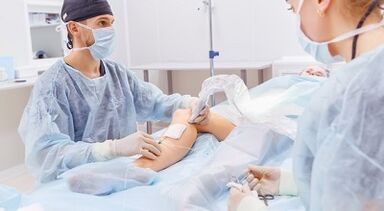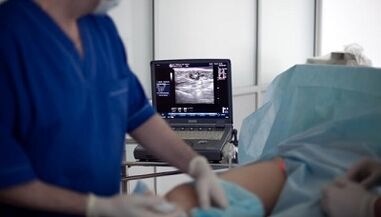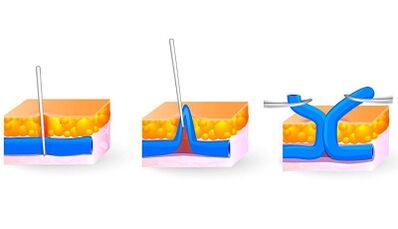
For decades, the treatment of foot varicose vein surgery remains the only radical method for eliminating the disease and its complications.
Thanks to modern technology and improving operating techniques, it is truly effective in therapeutic and cosmetic terms, it is carried out easily and without pain as possible, well received by the patient and does not cause prolonged defects.
Indications and contraindications
It is not recommended to handle patients with any varicose veins.There are clear signs of operation and contraindications to its implementation.
Varicose vein surgery from the lower leg is indicated in the following cases.
Medical indication-Significant 2-3 degrees of vein development, accompanied by complaints and signs of chronic vein failure:
- convincing, tense veins under the skin;
- various varics (nodes) along the changing vessels;
- the swelling of the affected leg;
- severity and pain along the expanded veins;
- seizures in the lower leg muscles, when "reducing the feet;
- Changes in inflammation in veins - thrombophlebitis;
- Dark trophilical skin disorders, redness, subcutaneous layer sealing, long wounds.
Cosmetic indications- Early (first) varicose veins without signs of venous deficiency, causing only cosmetic defects and aesthetic discomfort in the patient:
- Located superfically slightly growing and twisted;
- Vascular "stars", "spiders" and small redness-blue capillaries on the scalp.
It is important to remember that while there are signs of operation, one should refuse if the risk exceeds the benefit.
The main contraindication for the treatment of varicose vein surgery:
- Serious general conditions caused by acute (heart attacks, stroke, inflammation of the lungs) promote chronic illness (liver, friendly, pulmonary deficiency) or patients' old age.
- Any acute infectious disease.
- Conductive treatment for cancer.
- Spoken anemia.
- An increase or decrease in blood clotting.
- The process of inflammation and suppurative (score, rash) on the skin of the lower limbs, where surgical intervention is planned.
- Pregnancy and early childhood.
All contraindications, except the first one, are considered relative.This means that under special conditions (acute dangerous conditions caused by varicose veins, for example, thrombophlebitis in the thighs), one or another surgical treatment must be performed.
When emergency operations are required
Emergency surgical treatment on foot varicose veins may be needed in just one case - with acute ascending thrombophlebitis.This complication is inflammation in the large subcutaneous vein lumen, accompanied by the formation of blood clots.

If such a pathological process occurs in the thighs, there is a risk of blood rolls into the venous system.In the event of a blood clot, he penetrates the vessels of the lungs and clogs, which causes a life that threatens dangerous diseases -pulmonary thromboembolism (pulmonary fiber).
The main manifestations of the growing thrombophlebitis thrombophlebitis:
- pain along the veins along the inner surface of the thigh;
- redness and increase in skin temperature;
- The area of the changing area and its sharp pain in the palpation.
With ascending thrombophlebitis, the amount of surgical treatment can be represented:
- Crossectomy - dress and intersection of large subcutaneous veins at the meeting place with Bednaya;
- Removal of veins that change after early dressing.
Surgical intervention goal
Usually, about 30% of blood from the lower legs flow through a small subcutaneous river, which combines in two central veins - large and small subcutaneous veins.These vessels are directly connected to deep veins, where 70% of the blood flows out.In place of these compounds there are valves that pass through the blood only from the surface to the deep.
There are also dozens of small veins, called Perforant, also connect the surface vein network.They also have valves that pass through blood in one direction.
The main cause of varicose veins is the failure of the vein valve, leading to improper blood discharge: from the veins to the surface, which increases the pressure in it and leads to the expansion of both small vessels and central veins.
The main goal of which surgical treatment is intended for varicose veins from the lower leg:
- The removal of blood stagnation in the variable surface veins, which will prevent the development of chronic vein deficiency and trophic disorders on the skin.
- Removes vessels and defective varieties that represent cosmetic defects.
- The removal of blood release from deep veins - ligation and perforant intersection (clan) veins, as well as large and small subcutaneous veins in places of their relationship with the deepest.
- Prevention of repeated venous events.
Preparation for operations
Full preparation for surgical treatment for varicose veins includes:
- General preoperative examinations that allow you to evaluate blood and general urine tests of patients, coagulograms, biochemical analysis, blood type and RH factors, syphilis tests, blood sugar levels, lung radiography, ECG.
- Special diagnostics that allow you to determine the characteristics of the disease - ultrasound with doppler mapping of surface color, deep veins and arteries from lower legs and points the location of non -solvent perforant veins.
- This operation is performed on an empty stomach, so in the morning on the day of surgery you cannot eat and drink.
- In the morning before surgery, it is necessary to carefully shave all the hair on the foot from the thigh to the foot.
The treatment of female varicose veins

Separate places in the treatment of female varicose vein surgery at the bottom of the extreme of cosmetic surgery.After such intervention, not only the veins are pathologically altered, but also post -operative scars on the scalp, or they do not make it.
To achieve the maximum cosmetic effect, surgical surgery for varicose veins is performed according to the following methods:
- Laser or radio frequency ablation-Burning large subcutaneous veins of the subcutaneous vein under ultrasound control through the skin of the thighs or on the feet.
- Stem and sclerotherapy sclerobliteration-Make large and small subcutaneous veins, as well as all of their streams, even the smallest, with special sclerocant medicine.
Wherever the treatment method is described, varicose veins are not removed, but turn from the blood vessels to a soft cicatricial fabric.Both physical influences (laser rays, radio frequency waves), and chemical compounds (sclerosants) destroy the inner layer of the veins.Thanks to this, it loses the lumen, glue and completely desolates from the blood, turning into a common connective tissue (cicatricial).
Therefore, without the direct removal of the veins, all the goals are assigned to the rapid treatment of the vein in the lower leg - the changed vessel is eliminated, and the harmful consequences of venous deficiency is eliminated in it.
The only cosmetic operation restrictions in the treatment of varicose veins in women may be small or limited to veins to 1-2 degrees.During pregnancy and in the early days of childbirth, surgical treatment is contraindicated with the exception of acute situations that require emergency intervention, for example, with ascending thrombophlebitis.This operation is limited to large subcutaneous venous clothing at its relationship to femoral (crossectomy).
The type of surgery operation
Consider the most common surgical intervention in the treatment of varicose veins from lower legs: laser ablation, endoscopic vein surgery and phlebectomy.
The last is divided into the following types:
- classic operation, or complete or complete operation of trojanov-trendelenburg-bubko-narata;
- short stripping;
- Miniflebectomy.
Flebectomy
Removal, extraction of veins from under the skin is called phlebectomy.This is one of the first methods of surgical treatment for varicose veins from the lower leg.But today, phlebectomy is most commonly performed by phlebologists and vascular surgeons.There are three modifications and operating methods: full, short stripping, minafebectomy.
Intervention volume presented:
- As a large subcutaneous vein bandage at the meeting place, 2-3 cm on the thighs under the inguinal folds, in the thighs, through the slice.
- Its removal throughout the thigh to the foot using a special investigation through two skin wounds 1-2 cm along the deep surface near the knees and ankles.
- The removal of all varicose veins and small veins through a separate small incision is about 1-2 cm (they can from 5-6 to 10-20) with non-solvent perforant clothing.
- Sew all wounds with cosmetic stitches.
The most radical classical phlebectomy allows you to remove varicose veins, but the most traumatic of all available techniques.
Short stripping
With short stripping, not the whole subcutaneous vein is removed, but only the fragments, which are influenced by varicose veins, for example, only on the thighs or in the lower leg.Healthy segments are not removed.This reduces the trauma of intervention, but the risk of relapse is remained.Otherwise, operating operations are similar to classic phlebectomy.
Miniflebectomy

Innovative methodology to remove small varicose veins from large subcutaneous veins is called minafebectomy.
For its implementation, special tools (scalpels, hooks, clamps, spatulas) are required, with veins extracted through the skin of a few millimeters.It is not necessary to sew such skin defects, scars are not visible.
Often, surgeons combine short or complete stripping of large subcutaneous veins with minafebectomy.Such combined operations combine radicalism and minimal trauma with good cosmetic effects.
Endoscopic engine vein surgery
Finding all the lower perforate veins whenever the phlebectomy is difficult.For this purpose, endoscopic equipment (video cameras and manipulators) are used.Through small cuts in 1-2 cm, they are inserted under the skin in places of perforant veins, which are detected by ultrasound.
Under the camera control, all the lower perforators are looking for, wrapping and crossing it.During this operation, the subcutaneous veins are not removed.It can be done independently and combined with any type of phlebectomy: stripping, minafebectomy.
Laser treatment
Laser ablation for varicose veins involves burning with laser beams from large subcutaneous veins throughout the side of its release.To do this, through the piercing of the skin on the thighs or in the ankle area into the vein lumen, a catheter creature is introduced to the whole length.Under the control of the ultrasound, the svetovod is slowly extracted.
The laser beam, which acts on the vein wall, destroys the inner layer.As a result, Vienna falls and stops functioning, which is clearly visible to the ultrasound monitor.If not only the main vein, but also the stream, is removed by varicose veins, it is removed according to the miniflebectomy method.
Convalescence
No matter what method of surgery treatment varicose veins are used, the recovery of patients during the postoperative period occurs quickly.Full recovery conditions depend on the surgical methodology, the level of the disease and the general condition of the patient.With the treatment of laser and miniflebectomy early varicose veins, it is 2-3 weeks, with classic phlebectomy for sophisticated forms of the disease-3 months.
Walking is recommended as early as possible, provided that the condition is stable after anesthesia - after 5-6 hours.If spinal anesthesia is performed, bed break is recommended within 12 hours.With local anesthesia, the patient can leave the operating room on his feet and not be hospitalized in the hospital.The main condition before walking is to wrap your feet with elastic bandages or to wear individually selected compression knitwear.
Living in the hospital from 1-2 to 5-8 days.If the stitches are focused, it is best to remove it for 7-8 days during a specialist inspection from a specialist.Within a month after surgery, it is recommended to wear compression knitwear.It needs to put it every day before getting out of bed.At night, compression products are released.After classic phlebectomy with severe varicose veins, it is best to continue compression for up to 3 months.
Throughout the month, it is strictly prohibited:
- sauna and hot bath;
- heavy physical activity in the lower limbs;
- Stay long in a position that does not stand or sit.
The possibility of complications
The most common complications related to the operation for varicose veins:
- Pain in the feet is controlled by damage to the large nerves.
- Swelling of lower leg and legs.
- Hematoma and bruises on the lower leg and thighs.
- Bleeding from the wound.
- Flebotrombosis - inflammation of the veins.
- Surveillance of postoperative wounds and necrosis (hatred) of the surrounding skin with the formation of trophic ulcers.
- Formation of rough post -operative scars.
Thanks to modern methods and technologies, varicose vein surgery treatment is simple, painless and with high efficiency.Compliance with all postoperative period proposals contributes to rapid recovery, minimizing the risk of complications and relapse of the disease.























